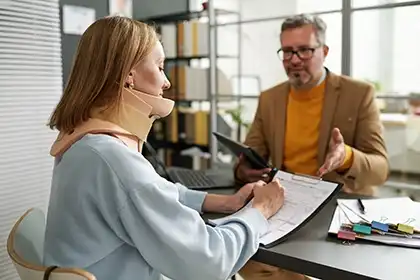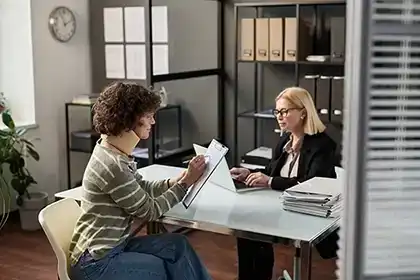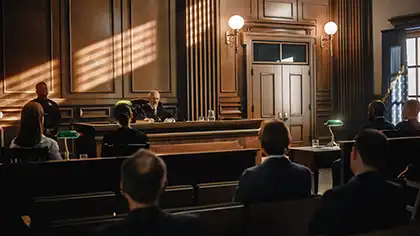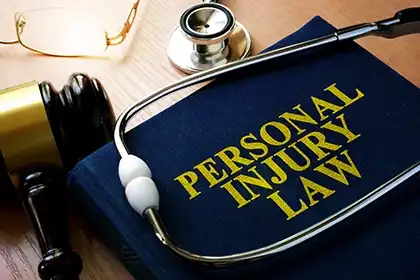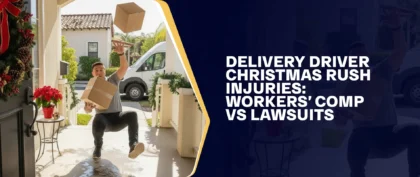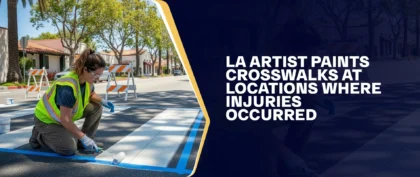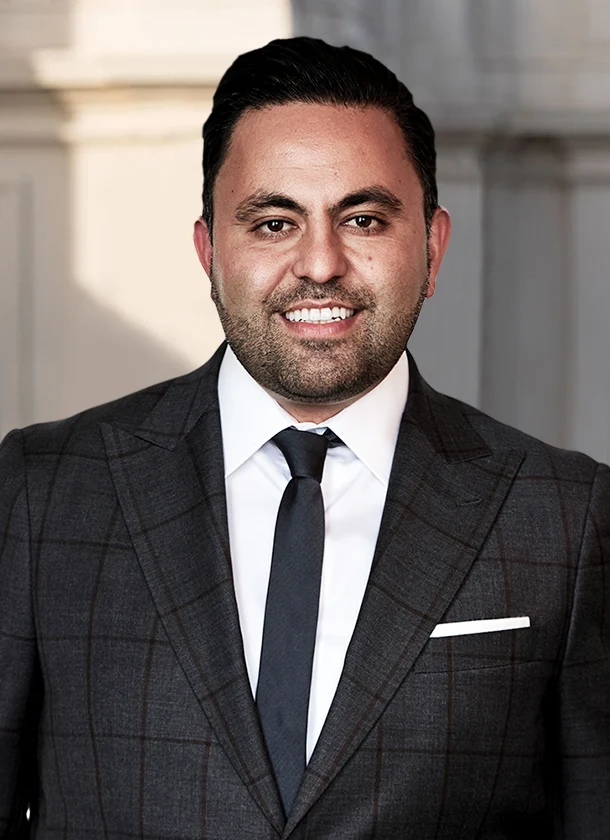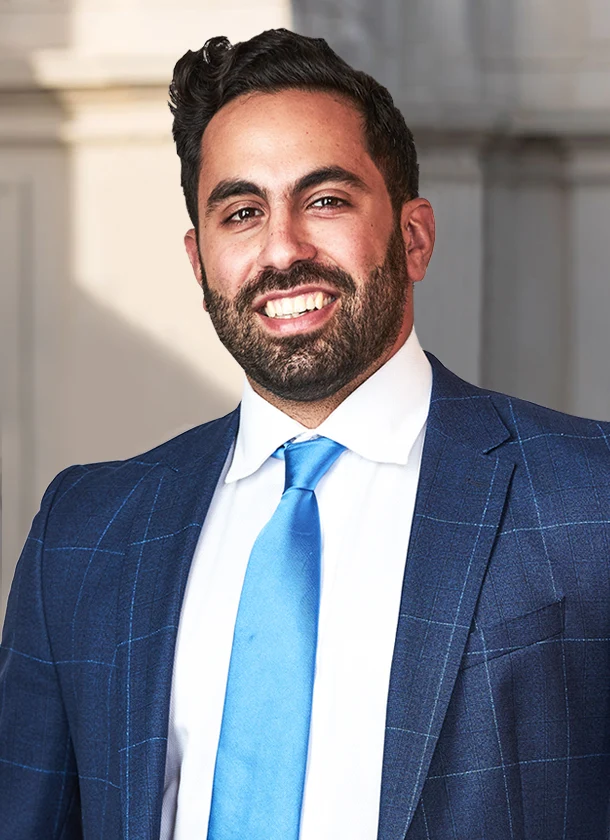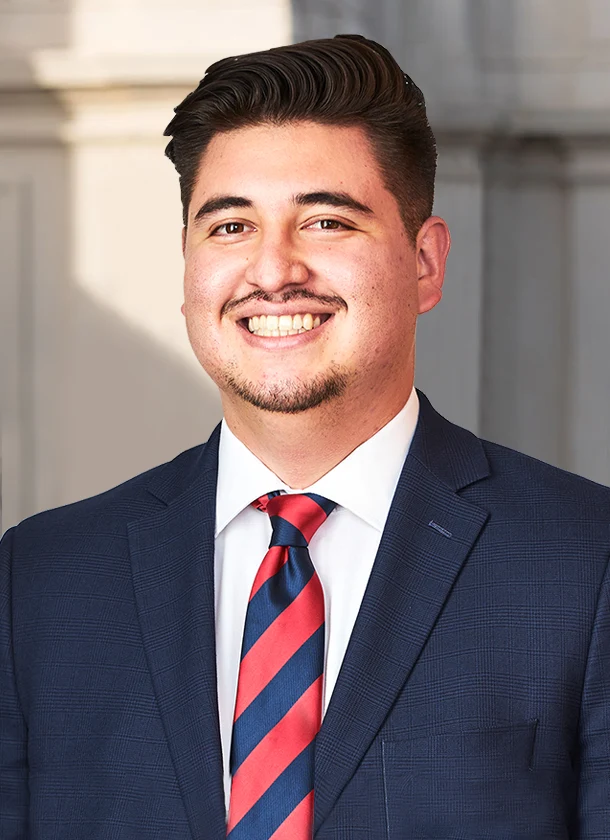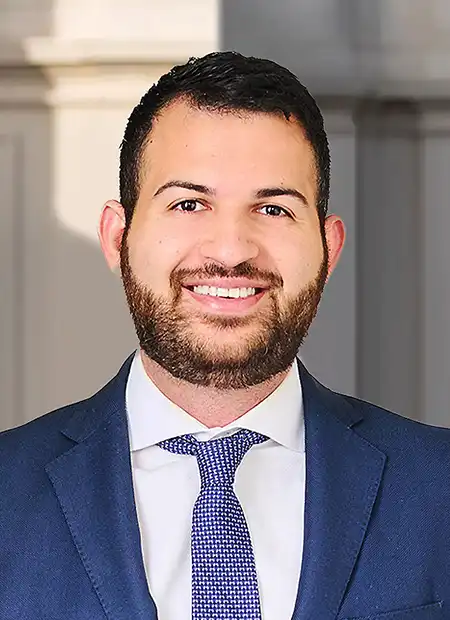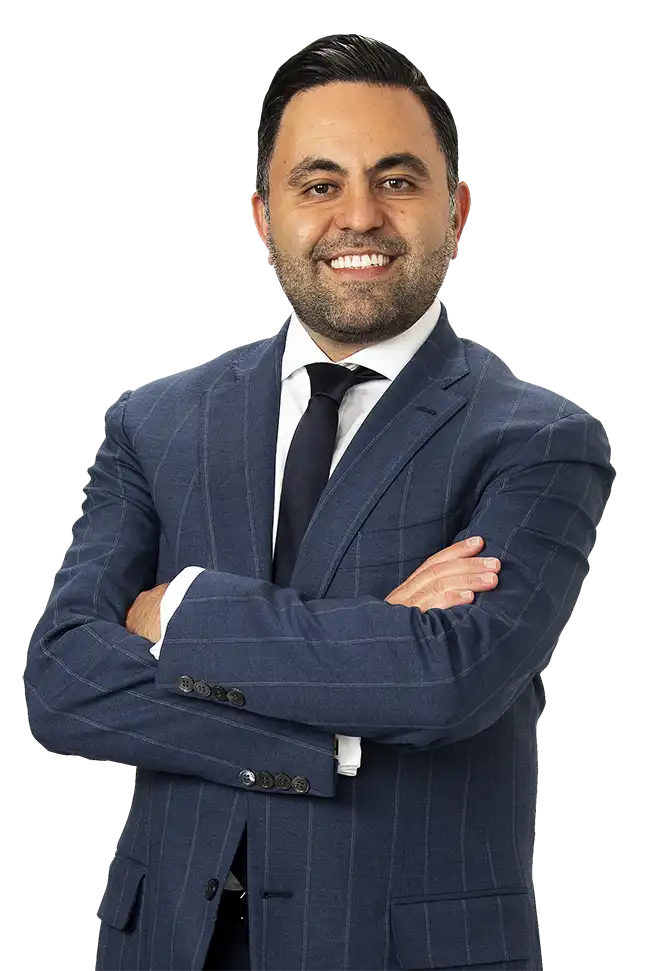Table of Contents
Filing a personal injury claim can be challenging, especially if you’re unfamiliar with the legal process. While the system is designed to hold negligent parties accountable and compensate those injured, the process can seem complicated and overwhelming to anyone unfamiliar with it.
Misconceptions about personal injury claims are also common. Many people, influenced by dramatic courtroom scenes in movies and television, believe that all cases end up going to trial. On the contrary, the reality is quite different. Most claims are resolved in out-of-court settlements.
There are several stages in a personal injury claim before it reaches trial. The whole process can be tricky, and challenges can arise along the way. Even minor errors in filing or managing your case can reduce your chances of obtaining compensation and have serious consequences.
That’s why it’s so important for you to understand how everything works clearly or, better yet, have an experienced personal injury attorney handle your case. They can help you avoid common pitfalls, help protect your rights, and pursue the fair compensation you may be entitled to.
Understanding The Personal Injury Claim Process
Although each personal injury case is unique, the legal process in California generally involves two main stages:
- Stage 1 — Filing a claim with the insurance company.
- Stage 2 — Pursuing compensation through a lawsuit.
It’s unfortunate when an accident or injury occurs, but a personal injury lawyer can guide you through the legal process from beginning to end.
Your personal injury claim journey begins with the unfortunate accident that caused your injury, which is the basis of your claim. Whether it’s a car collision, slip-and-fall, motorcycle crash, product liability case, or another mishap, the nature and severity of your injuries have a strong bearing on your case. The circumstances surrounding the accident, including fault and the extent of damages, will be meticulously evaluated to build a strong case.
One critical aspect to consider is the statute of limitations for personal injuries in California. Generally, victims have two years from the date of the accident to file a personal injury claim, with the following exceptions:
- The plaintiff is a minor, legally insane, incapacitated, or in prison.
- The defendant is out of state.
In these cases, the clock stops until the plaintiff turns 18, is declared sane, recovers from incapacity, is released from prison, or the defendant returns to California. Understanding and adhering to these time limits is crucial, as missing the deadline can result in losing your right to file a lawsuit.
While two years may seem like ample time, it’s best to act promptly. Contact a personal injury attorney to help you initiate and manage the claims process. Here’s a general outline of what to expect at each stage:
Stage 1 — Filing A Personal Injury Claim With Insurance Companies
This stage includes deciding whether to hire an attorney, gathering necessary evidence, and notifying the responsible parties of your claim. This phase lays the groundwork for negotiations, potential settlements, or further legal action.
Hiring A Personal Injury Attorney
While not every personal injury claim requires an attorney, hiring a California personal injury lawyer is advisable. The process typically begins with a free initial consultation, which can be conducted in person, over the phone, via text, through a case review form, or even via an online chat.
During this meeting, a lawyer will review the accident details and assess the legal grounds of your claim. They’ll explain how they can assist, including gathering evidence, handling documentation, and managing your claim from start to finish.
If the personal injury attorney decides to take on your case, the next step is signing a contract. This agreement formalizes the attorney-client relationship and outlines the role, responsibilities, and fees. They’ll also let you know what initial documents they’ll need from you to get started.
Investigation And Claim Notification
Once you’ve hired lawyers handling personal injury cases, they’ll start investigating your case to identify who may be at fault and gather evidence to support your claim. This can involve visiting the accident site, reviewing medical records and bills, collecting witness statements, and even consulting experts to support your case.
Your attorney will ask for any documentation you have related to the accident, such as photos of the scene, proof of property damage, and medical records. They’ll also look into the details of the accident to understand how your injury occurred, its extent, and the associated costs.
Your personal injury attorneys will handle all the investigative work behind the scenes. Your main focus should be on your recovery and following your medical treatment plan.
Once the important details and evidence have been gathered, your personal injury lawyer will notify the at-fault party and/or their insurance through a demand letter. The document details the reasons for the individual’s responsibility, describes the severity of your injuries, and specifies your demand for compensation. It specifies the amount you are seeking for your injuries and indicates that a lawsuit may be filed if an agreement can’t be reached.
Negotiations And Settlements
When the demand letter is sent, the insurance company reviews it and may counter with a lower offer. Your lawyer may negotiate for a higher settlement, depending on the specific facts of your situation and available evidence. You’ll be informed of offers and decide together if they will cover your losses.
Once you agree on an amount, it’s written in a settlement agreement, signed by both parties, and the defendant’s insurer arranges payment. After finalizing, no further legal action can be taken on the case, so check whether the compensation you are pursuing covers all your damages.
Many personal injury cases settle outside of court, as it’s faster and less stressful than a trial. If negotiations fail or if the statute of limitations is close, your lawyer may file a lawsuit to protect your claim.
Stage 2 — Filing A Personal Injury Lawsuit
The case only enters this stage if no resolution is reached through negotiation. This process begins with filing a complaint or petition, which is the official document that initiates the lawsuit.
At this point, you become the plaintiff, and the party you’re suing is called the defendant. The complaint outlines the facts of the case, details how you were injured, describes the damages you’ve suffered, and explains why the defendant should be held responsible under the law.
In California, you typically have a two-year window from the date of your injury to initiate a personal injury lawsuit, making it imperative to begin the process promptly. In addition to the initial negotiations with the insurance company, which can already be time-consuming, preparing and filing the required legal documents also demands time.
Before your case goes to trial, your attorney will prepare by reviewing your evidence and collecting more if needed. They will document all of it and preserve any physical evidence in a secure location. They will investigate the accident further to check that all information is properly documented and organized. Your injury lawyer will also review applicable laws and case law to identify legal theories. Then, using all evidence and applicable law, they will develop a sound legal strategy.
At Arash Law, we approach each claim with a trial in mind from the very start. Solid preparation from the very beginning means we are already equipped with everything we need should negotiations fail and we take the case to court. That means we’re ready to file the case as soon as we need to.
Pre-Trial Phase
Discovery typically occurs during the pre-trial phase of a lawsuit. This is when both parties exchange information and evidence to prepare for trial.
Here are some of the common discovery methods used in personal injury cases:
- Interrogatories — Written questions that one party sends to the other, requiring written answers under oath. These questions help clarify details about the case.
- Depositions — Oral examinations under oath, typically conducted by attorneys. Witnesses and parties involved provide verbal testimony, which is recorded and can be used in court.
- Requests for Production of Documents — Formal requests for specific documents, such as medical records, photographs, emails, and other relevant evidence. These documents provide crucial information to support the case.
- Requests for Admissions — Requests for the other party to admit or deny certain facts related to the case. These admissions can simplify the trial by establishing facts that are not in dispute.
The timing and scope of discovery can vary depending on the complexity of the case and the specific rules of the court. These methods are essential for gathering the necessary information to build a strong case for trial.
Engaging In Further Discussions Through Mediation Or Arbitration
Due to the court’s calendar and caseload, it can sometimes take months to secure a trial date. Before a trial date is set, the parties may opt to go through mediation to attempt to settle prior to committing to a trial. The court may also order them to go through arbitration. These are called alternative dispute resolution (ADR) methods, and they are used to resolve disputes outside of the traditional court system. While they share the goal of finding a resolution without going to trial, they differ in their processes and outcomes.
Mediation is a voluntary process involving a neutral third party who facilitates communication between the parties to help them reach a settlement. On the other hand, arbitration is mandated by the court if both parties agree and involves an arbitrator.
The mediator’s role is simply to facilitate negotiations, but they cannot impose a decision. An arbitrator, who is often a retired judge or attorney with experience in the relevant field, hears evidence and arguments from both sides and then makes a binding decision.
This phase sometimes takes a few weeks or several months, depending on when the trial is scheduled. Many cases are resolved during this stage, avoiding the need for a trial altogether.
According to California law, a judge may order mediation to help the parties resolve their disputes, particularly for personal injury claims with damages under $50,000. ADR methods are generally quicker and more cost-effective than going to trial, as they aim to reach a fair agreement without the intricacies and expenses of a court trial.
Appearing In Court
If ADR attempts don’t lead to a settlement, the case moves to trial. In California, trials can last from a few hours to several weeks or even months, depending on the case’s complexity and the specific issues involved. During the trial, both sides present their evidence and arguments before a judge or jury, who will then decide based on the facts and legal standards.
Throughout this stage, your attorney will serve as your legal advocate and representative, presenting your case to the other party. They will introduce evidence, call and cross-examine witnesses, and craft compelling arguments to support your claim. Your personal injury attorneys will also handle all procedural aspects and work to uphold your rights at every step.
Post-Trial
A verdict isn’t necessarily the end of the process. If either party believes that legal errors impacted the trial’s outcome, they have the right to file an appeal. This can extend the timeline of your case by several months or even years as a higher court reviews the claims and reconsiders the case.
However, suppose a judge or jury delivers a verdict in your favor, and the opposing party does not appeal the court’s decision. In that case, the next step is to resolve any outstanding liens. Liens are claims made by a third party, such as a medical provider, against a portion of your settlement or award to ensure they are paid for services they provided with no upfront payment.
Payment Disbursement
Afterward, your attorney’s fees and any case-related expenses will be deducted from the remaining settlement amount. Once these payments are made, the rest of the award will be disbursed to you.
You generally have two main options for receiving your compensation: a lump sum or a structured payment.
- Lump Sum Payment — With a lump sum payment, you receive the entire amount. This option provides immediate access to the full amount, allowing you to use the money as you see fit.
However, having a large sum of money upfront can be tempting, and without careful management, there’s a risk of overspending or making hasty financial decisions. If managing a large sum feels overwhelming, you might find that a structured payment plan is a better fit for you. - Structured Payment — A structured payment means you will receive your compensation in regular installments over a specified period, usually one to five years. This method is particularly helpful if you need to cover ongoing expenses, such as medical bills or living costs, over time.
A periodic settlement can help you maintain steady financial management and avoid overspending. However, if you have immediate, large expenses or urgent needs, waiting for periodic payments might be challenging, as you won’t have access to the full settlement amount right away.
Choosing between a lump sum and structured payments depends on your financial situation and how you plan to use the money. You can discuss these options with your attorney. They will help you make an informed decision that suits your needs and circumstances.
The Time Required To Settle A Personal Injury Case
The timeline for an injury case depends on many factors. The duration of each phase can vary, affecting the overall length of the legal proceedings. In California, for example, a claim can take anywhere from a few months to several years to settle. Here are the factors that could influence the timeline of your personal injury lawsuit:
Nature Of Your Injuries
The extent and type of your injuries significantly affect your case timeline. Severe injuries like traumatic brain injuries (TBIs), spinal cord damage, or multiple fractures require extensive treatment and take longer to settle due to the need for detailed documentation. Less severe injuries, like minor fractures or soft tissue damage, can be resolved more quickly. Your lawyer, experienced in personal injury cases, might recommend delaying your claim until the full extent of your injuries is clear, allowing all future medical costs and impacts to be accounted for.
Case Complexity
Cases involving multiple responsible parties or requiring expert witnesses are typically more complex and take longer to resolve. When there are multiple defendants, each one may have their own insurance and lawyer, making things more complicated. Needing expert witnesses for certain aspects, like medical reasons or damages, also makes the case last longer because it takes time to get and prepare their statements. Additionally, organizing everyone’s schedules and managing lots of paperwork can further delay the process.
Whether Or Not Liability Is Contested
Overwhelming evidence pointing to the defendant’s negligence can expedite your case. There is less need for extensive negotiation and legal maneuvering to establish fault. Insurance companies may also be more inclined to settle promptly to avoid the potential costs and risks associated with a lengthy legal battle.
However, if liability is opposed, the case can become significantly more complex and time-consuming. Both parties may engage in extensive negotiations, legal arguments, and potentially even multiple rounds of discovery if new information arises. These aspects can delay your case.
Insurance Company Cooperation
The level of cooperation from the insurance company can significantly impact the timeline of a personal injury case. When an insurance company is cooperative and willing to negotiate in good faith, the case can often be resolved more quickly.
However, victims may encounter challenges in dealing with insurance companies, including delays or claim denials that can extend legal proceedings. They aim to reduce their financial liability and delay a possible trial, which can cause you to miss out on the deadline for filing a case. Other common issues include refusing to provide requested information, disputing the validity of claims, or raising frivolous defenses. Insurance companies may also offer low settlement amounts that do not accurately reflect the full extent of the victims’ losses. As a result, the injured party may be forced to negotiate and litigate to pursue fair compensation. These challenges can significantly prolong the process.
Hiring A Personal Injury Attorney
Hiring an attorney can affect the timeline of a personal injury case. Attorneys experienced in handling personal injury claims usually work to negotiate settlements on behalf of their clients. These legal representatives are skilled in dealing with insurance companies and understand their tactics. Furthermore, they have extensive resources, such as staff, technology, and funding, and can devote more time and attention to the case.
Client Cooperation
Your cooperation is vital throughout the legal process to avoid delays and pursue a favorable outcome. Changes in contact information or a lack of timely responses to requests from your attorney can cause significant setbacks.
Maintaining open and consistent communication with your personal injury attorney helps keep the case on track and prevents potential disruptions to the process. Any lapses in communication or delays in providing necessary information can adversely affect the outcome of your case.
Common Types Of Personal Injury Cases
As you navigate the stages of a personal injury case, it’s helpful to understand the common types of personal injury claims in California. Each type of case may follow a similar process, but the specifics can vary based on the nature of the injury.
Car Accidents
Car accidents are alarmingly common. They occur when a vehicle collides with another vehicle, a pedestrian, or an object, leading to injuries or property damage. These accidents can range from minor fender-benders to serious, life-threatening crashes. Due to their frequency and potential severity, they are a leading cause of personal injury claims.
These incidents often result in injuries, affecting thousands of individuals each year. In the Golden State, the high traffic density in urban areas like Los Angeles, San Diego, San Jose, and San Francisco contributes to these frequent occurrences. Victims commonly sustain injuries such as:
- Whiplash
- Fractures
- Head Injuries
- Brain Injuries
- Spinal Cord Injuries
- Internal Injuries
- Soft Tissue Injuries
- Burns
- Dislocations
- Cuts and Bruises
If you’ve been injured in a car accident, consult with a car accident lawyer. An experienced attorney can help navigate the legal process, negotiate with insurance companies, and pursue fair compensation. They can also guide you in gathering evidence and arranging medical liens, working to help protect your rights throughout the claim process.
Truck Accidents
Truck accidents involve collisions with large commercial vehicles like 18-wheelers or delivery trucks, often resulting in significant damage and severe injuries. In 2022, the NSC reported 5,837 fatal crashes involving large trucks.
Types of truck accidents include:
- Rear-End Collisions — This happens when a truck crashes into the back of another vehicle.
- Jackknife Accidents — Improper braking and high-speed maneuvers, among other things, cause the truck trailer to swing out, forming an angle with the cab.
- Rollover Accidents — Improper loading and sudden turns can cause a truck to overturn, particularly when it has a high center of gravity.
- Tire Blowouts — Tire blowouts happen when a truck’s tire is low on air or worn out, the truck is overloaded, there’s debris on the road, or the truck is moving too fast.
- Wide Turn Accidents — Smaller vehicles can get caught in the truck’s wide turning radius if the driver isn’t careful.
- Underride Accidents — A smaller vehicle can slide under the rear or side of a truck if the truck suddenly brakes without warning.
If involved in a truck accident, consult a personal injury attorney experienced in trucking regulations. They will help identify liabilities due to driver negligence, company policies, or faulty equipment. Key evidence includes driver’s logbooks, ELD data, truck maintenance records, black box data, and cargo loading records.
Motorcycle Accidents
Motorcycle riding is fun, exciting, and convenient, but it also entails certain unique risks. Riders face more dangers in accidents due to their exposure, and even with safety gear, injuries can be severe and life-altering.
Many factors can contribute to serious motorcycle accidents, often increasing the severity of the crash. Some common causes include:
- Speeding
- Inexperienced Driver
- Unsafe Road Conditions
- Improper Lane Changes
- Reckless Driving
- Defective Motorcycle Parts
- Poor Visibility
- Distracted Driving
Accidents are especially common at busy intersections or when riders act negligently. In these challenging situations, having dependable legal support is crucial. Skilled motorcycle accident attorneys can help victims navigate the complex legal system to seek justice and fair compensation.
Pedestrian Accidents
Pedestrians struck by vehicles often suffer severe injuries due to their lack of protection. The National Center for Biotechnology Information (NCBI) identifies the most frequent injuries from pedestrian accidents seen in emergency rooms as including head and brain injuries, spinal and back injuries, injuries to the musculoskeletal system, bone fractures, lacerations, and bruises.
In 2023, California reported 3,551 serious injuries and fatalities involving pedestrians, highlighting the growing risk. Skilled pedestrian accident lawyers can investigate incidents thoroughly, reviewing CCTV footage, eyewitness statements, and police reports to build strong cases.
Bicycle Accidents
Bicycle accidents are common due to cyclists’ vulnerability on the road. Riders often share the road with larger, faster vehicles, increasing their risk of serious injury. The National Highway Traffic Safety Administration estimates that over 4,400 people lost their lives in motor vehicle crashes across California in 2022.
Your skilled bicycle accident lawyers will investigate the accident, assess liability, and gather evidence such as traffic camera footage and witness statements. They will also handle negotiations with insurance companies to seek compensation on your behalf. Legal representation lets you focus on your recovery while knowing that someone is working to protect your rights.
Hit-And-Run Accidents
Hit-and-run accidents occur when a driver involved in a collision leaves the scene without providing contact information or assisting the injured. This complicates seeking justice and compensation for those affected.
The common causes of hit-and-run accidents are:
- Drunk Driving — Intoxicated drivers often flee the scene to avoid DUI charges.
- Reckless Driving — Those driving aggressively or carelessly may panic and drive away, fearing they will be held accountable.
- Lack of Insurance or License — Drivers without proper insurance or a valid license might leave the scene to avoid legal repercussions and financial liability.
If you’re injured in a hit-and-run, know that you may have legal rights and options for seeking compensation, even if the driver has left the scene. Hit-and-run accident lawyers can assist you in pursuing a claim for compensation, even if the responsible driver is never found. They will explore all available options, such as filing a claim with your insurance, gathering evidence, and advocating for your rights to pursue compensation for your injuries and losses.
Premise Liability
Premises liability arises from the property owner’s legal obligation to maintain safe conditions for anyone who enters their property, whether managing a business, private residence, or public area. They are responsible for preventing any harm from unsafe conditions on their premises. This includes addressing hidden dangers that may not be immediately apparent to visitors.
The legal “duty of care” means that property owners must:
- Maintain the Property — Ensure that all areas of the property are kept in a safe condition to prevent accidents.
- Inspect the Property — Regularly check for potential hazards that could pose a risk to visitors.
- Repair Dangerous Conditions — Promptly fix any issues that could lead to injury.
- Warn of Hazards — Provide clear warnings about any dangerous conditions that are not obvious.
If a property owner fails to meet this duty of care and causes an accident, injury lawyers who handle premises liability cases can help. They can investigate the incident, gather evidence, and advocate for your rights to pursue damages. They will handle the legal aspects of your case so you can focus on your recovery.
Wrongful Deaths
Wrongful deaths occur when someone dies due to another person’s negligence or intentional harm. The deceased person’s surviving spouse, children, or parents often pursue these cases. Various circumstances can lead to a wrongful death claim, including:
- Intentional Acts
- Vehicle Accidents
- Medical Malpractice
- Defective Products
- Unsafe Premises
- Other Negligent Acts
No amount of money can eliminate the pain of losing a loved one. Still, the law allows legal heirs to pursue damages in a wrongful death claim. These might include:
- Medical Expenses — Covering any accident-related medical costs incurred before your loved one’s passing.
- Funeral Expenses — Assisting with funeral, burial, or memorial service costs.
- Other Economic Damages — Compensating for financial losses, such as loss of income or benefits your loved one would have provided.
- Non-Economic Damages — Addressing the emotional impact, including pain and suffering or loss of companionship.
This compensation is designed to support you during a challenging time and help ease the financial burdens of such a profound loss. Additionally, wrongful death lawyers will assist you in filing a wrongful death claim. They will guide you through the legal process to seek justice and restitution for your family.
Other Types Of Personal Injury Cases
Personal injury cases cover a broad spectrum of accidents and incidents that can result in serious harm. Beyond the more common car accidents, several other scenarios can lead to significant injuries and legal claims, such as:
- Rideshare Accidents — Services like Uber and Lyft have become widespread, leading to rideshare accidents involving drivers and passengers. These cases often involve complex liability issues and insurance claims.
- Bus Accidents — Bus accidents can occur due to driver negligence or vehicle malfunctions. Due to their size and impact, injuries from such accidents can be severe.
- Slip-and-Fall Accidents — Wet floors or uneven surfaces are common causes of slip-and-fall accidents. These are compensable if the owner was negligent.
- Dog Bites — Dog bites can cause serious injuries and infections. California law holds dog owners strictly liable in most of these incidents.
- Harbor and Port Accidents — Accidents in harbors and ports often involve heavy machinery or hazardous conditions. Workers and visitors can suffer from injuries caused by equipment malfunctions or unsafe practices.
- Helicopter Crashes — Helicopter crashes result from issues with aircraft maintenance, pilot error, or other technical failures.
- Nursing Home Abuse — Abuse in nursing homes can lead to physical and emotional harm to elderly residents. Cases often involve improper care or mistreatment by staff.
- Train Accidents — Train accidents can cause significant damage due to the size and speed of trains. They often involve complex investigations into rail safety protocols and driver conduct.
If you’re injured in an accident, you can search “California personal injury attorney near me” to seek help. They bring extensive knowledge to navigate complex legal issues and advocate for your rights. Whatever type of injury case you might have, a skilled attorney can help you pursue fair compensation.
What To Consider When Hiring A Personal Injury Lawyer
The State Bar of California licenses over 266,000 attorneys to practice law, with 190,000 currently holding active status. With so many options available, you should know what qualities to look for in a lawyer who will effectively handle each stage of your claim.
Here are some factors to consider when hiring a personal injury lawyer:
- Experience — Choose a lawyer who has substantial experience handling cases similar to yours. A lawyer knowledgeable in personal injury law will better understand the legal landscape and how to approach your case.
- Reputation — Look for someone well-regarded in the legal community and by former clients.
- Communication Skills — Choose an attorney who communicates clearly and keeps you informed throughout the process.
- Availability — Ask whether the lawyer you choose has the time to dedicate to your case.
- Legal Fees — Discuss the attorney’s fee structure upfront. Many personal injury lawyers work on a contingency basis, meaning they are paid attorney’s fees only if compensation is obtained. Clients may still be responsible for case-related costs regardless of the outcome.
- Client Reviews — Look at reviews from past clients to get a sense of the lawyer’s strengths and weaknesses. Positive reviews may be good indicators of the quality of service you can expect.
- Responsiveness — Choose an attorney who responds promptly to your calls and emails and updates you on developments.
- Track Record — Consider the lawyer’s track record of success in personal injury cases. A history of favorable settlements or verdicts is a good sign.
- Trial Experience — While most cases settle out of court, having an attorney with litigation experience is important. If your case goes to trial, you want someone qualified and capable of representing you in the courtroom.
Our lawyers from our California injury law firm are committed to pursuing a favorable outcome for your case. Contact us for a free initial consultation.
Frequently Asked Questions
What Should I Do After I Get Injured?
Amidst the chaos and confusion of an accident, filing a personal injury claim might not be your priority. However, your actions right after the incident can be crucial to the outcome of your case.
To help protect your well-being and support a potential claim, you can follow the general recommended steps below:
- Seek Medical Attention — Your health is a priority. Get medical help immediately, even if your injuries are minor. A medical professional can identify and treat any injuries you might not notice, such as internal damage that could worsen over time. Also, a prompt medical visit creates a detailed record of your injuries, which is crucial for linking them to the accident and supporting your claim.
- Collect Evidence — Capture photos of the accident scene and any visible injuries. If other parties are involved in the accident, make sure to get their details, including names, contact numbers, and insurance information. If there are witnesses, get theirs as well. This documentation will be invaluable for supporting your claim and providing a clear picture of the incident.
- Report the Incident to the Appropriate Authorities — Whether it’s the police, your employer, or another relevant entity, their reports will document the circumstances of the accident. They can be extremely useful in your case.
- Consult an Attorney — Speak with a lawyer who focuses on personal injury cases. A skilled attorney will work to pursue compensation on your behalf. Their knowledge of personal injury law allows them to navigate the complexities of your case.
What Is Considered A Personal Injury?
A personal injury refers to injuries or damages suffered as a result of incidents such as slip-and-fall accidents, vehicle collisions, and dog bites. The severity of these injuries can vary. While minor injuries may heal more quickly, they still require time and money for treatment.
Severe injuries, such as traumatic brain injury (TBI), can have profound and lasting effects, often necessitating extensive medical care and ongoing support. If someone else’s negligence caused your injury, consult a personal injury lawyer to pursue compensation for your damages.
What Are The Common Types Of Personal Injuries?
The common injuries in personal injury cases include broken bones, burns, internal bleeding, and spinal cord injuries. These injuries often lead to neck and back issues, disfigurement, or even loss of limbs. Traumatic brain injuries are among the most severe and frequently result from car accidents or significant slip-and-fall incidents. Emotional injuries, such as post-traumatic stress disorder (PTSD), are also prevalent in personal injury claims.
These injuries can deeply impact a person’s quality of life, requiring extensive medical treatment and rehabilitation. Work with lawyers handling personal injury cases to help you seek appropriate compensation for your injuries and other losses.
What Is A Personal Injury Case?
A personal injury case arises when someone suffers harm due to the actions or negligence of another person, company, or entity. It’s the legal way for the injured party to seek compensation for the physical, emotional, or financial damages they’ve experienced.
Imagine you’re walking down the street, and someone’s negligence causes you to slip and fall, resulting in a broken arm. In this scenario, you might have a personal injury case against the person or business responsible for the unsafe condition that led to your fall.
These cases can cover many incidents, from car accidents and medical malpractice to slips and falls and dog bites. The key element is that someone else’s actions, or sometimes their failure to act, directly cause your injury. If you believe someone else is responsible for your injuries, a personal injury case allows you to seek justice and compensation for the impact they have on your life.
What Are The Chances Of Winning A Personal Injury Lawsuit?
Your chances of winning such a lawsuit depend on several factors, including how complex your case is and the quality of legal support you have. It’s advisable to hire an experienced lawyer who focuses on personal injury because they know how complicated personal injury law is and can help you get through the process. They can find credible evidence, talk to insurance companies, and advocate for your rights in court. Because of their experience, the legal process can be more manageable.
However, other factors can influence the outcome of your claim. Examples include the strength of the evidence and whether or not liability is clearly established.
Who Can Sue For A Personal Injury Case?
In California, the following individuals are allowed to file a personal injury case:
- Legal Permanent Residents — Individuals who hold a Green Card and legally reside in California can file a personal injury claim.
- Undocumented Immigrants — California law allows undocumented immigrants to file personal injury claims. They may be entitled to seek compensation for damages caused by another party’s negligence or wrongful actions.
- Legal Representatives — If the injured party is a minor, they cannot file a personal injury lawsuit on their own. In such cases, a parent or legal guardian must file the lawsuit on behalf of the minor. The legal representative manages the case and makes decisions in the minor’s interest until the minor reaches the age of majority.
If the injured party has passed away due to their injuries, their legal representatives (such as executors of their estate) can file a wrongful death lawsuit.
These individuals can seek damages for medical expenses, lost wages, pain and suffering, and other related costs resulting from the injury. You can also consult injury lawyers about the process if you are not familiar with it.
Schedule A Free Case Review With Our Personal Injury Lawyers!
If you handle your personal injury lawsuit yourself, you might feel overwhelmed, especially when you’re uncertain how long the process will take. Consult our experienced personal injury attorneys for a more precise timeline and tailored advice. We’ll assess your specific situation and provide a clearer understanding of what to expect.
Arash Law offers legal guidance in personal injury law and a strong commitment to our clients. We have the resources and experience to handle complex cases. Whether you’ve been injured in a car accident or suffered from a slip and fall, we’re here to help you seek compensation for your injuries.
No matter what type of personal injury case you’re dealing with, our team is ready to guide you through the legal process and work diligently on your behalf. Call us at (888) 488-1391 for a free case review.
We also extend our legal services to several cities in California, including Glendale, Oxnard, Visalia, Oceanside, Victorville, San Luis Obispo, Carlsbad, Los Angeles, San Diego, San Jose, Palmdale, Burbank, Compton, Temecula, Fremont, Santa Clara, and Pasadena.

